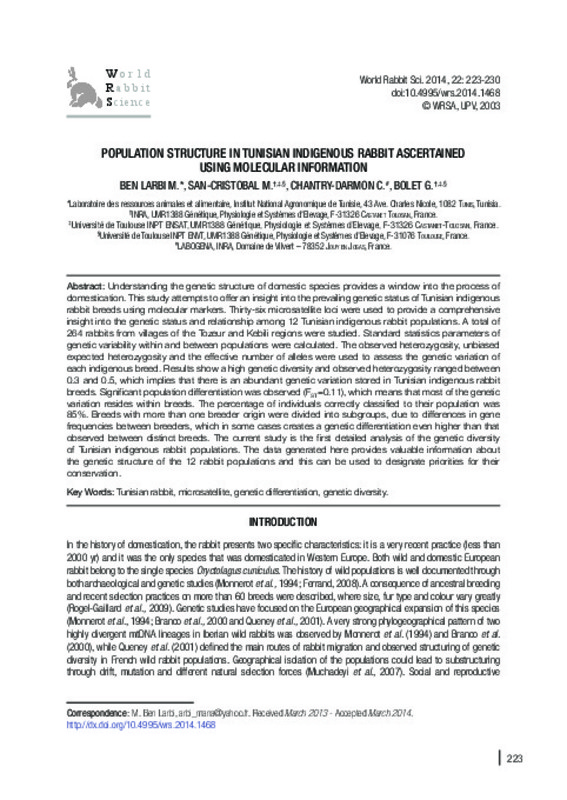JavaScript is disabled for your browser. Some features of this site may not work without it.
Buscar en RiuNet
Listar
Mi cuenta
Estadísticas
Ayuda RiuNet
Admin. UPV
Population structure in Tunisian indigenous rabbit ascertained using molecular information
Mostrar el registro sencillo del ítem
Ficheros en el ítem
| dc.contributor.author | Ben Larbi, Manel
|
es_ES |
| dc.contributor.author | San-Cristobal, M.
|
es_ES |
| dc.contributor.author | Chantry-Darmon, C.
|
es_ES |
| dc.contributor.author | Bolet, G.
|
es_ES |
| dc.date.accessioned | 2014-09-30T12:49:39Z | |
| dc.date.available | 2014-09-30T12:49:39Z | |
| dc.date.issued | 2014-09-30 | |
| dc.identifier.issn | 1257-5011 | |
| dc.identifier.uri | http://hdl.handle.net/10251/40463 | |
| dc.description.abstract | [EN] Understanding the genetic structure of domestic species provides a window into the process of domestication. This study attempts to offer an insight into the prevailing genetic status of Tunisian indigenous rabbit breeds using molecular markers. Thirty-six microsatellite loci were used to provide a comprehensive insight into the genetic status and relationship among 12 Tunisian indigenous rabbit populations. A total of 264 rabbits from villages of the Tozeur and Kebili regions were studied. Standard statistics parameters of genetic variability within and between populations were calculated. The observed heterozygosity, unbiased expected heterozygosity and the effective number of alleles were used to assess the genetic variation of each indigenous breed. Results show a high genetic diversity and observed heterozygosity ranged between 0.3 and 0.5, which implies that there is an abundant genetic variation stored in Tunisian indigenous rabbit breeds. Significant population differentiation was observed (Fst=0.11), which means that most of the genetic variation resides within breeds. The percentage of individuals correctly classified to their population was 85%. Breeds with more than one breeder origin were divided into subgroups, due to differences in gene frequencies between breeders, which in some cases creates a genetic differentiation even higher than that observed between distinct breeds. The current study is the first detailed analysis of the genetic diversity of Tunisian indigenous rabbit populations. The data generated here provides valuable information about the genetic structure of the 12 rabbit populations and this can be used to designate priorities for their conservation. | es_ES |
| dc.language | Inglés | es_ES |
| dc.publisher | Editorial Universitat Politècnica de València | |
| dc.relation.ispartof | World Rabbit Science | |
| dc.rights | Reserva de todos los derechos | es_ES |
| dc.subject | Tunisian rabbit | es_ES |
| dc.subject | Microsatellite | es_ES |
| dc.subject | Genetic differentiation | es_ES |
| dc.subject | Genetic diversity | es_ES |
| dc.title | Population structure in Tunisian indigenous rabbit ascertained using molecular information | es_ES |
| dc.type | Artículo | es_ES |
| dc.date.updated | 2014-09-30T11:24:14Z | |
| dc.identifier.doi | 10.4995/wrs.2014.1468 | |
| dc.rights.accessRights | Abierto | es_ES |
| dc.description.bibliographicCitation | Ben Larbi, M.; San-Cristobal, M.; Chantry-Darmon, C.; Bolet, G. (2014). Population structure in Tunisian indigenous rabbit ascertained using molecular information. World Rabbit Science. 22(3):223-230. https://doi.org/10.4995/wrs.2014.1468 | es_ES |
| dc.description.accrualMethod | SWORD | es_ES |
| dc.relation.publisherversion | https://doi.org/10.4995/wrs.2014.1468 | es_ES |
| dc.description.upvformatpinicio | 223 | es_ES |
| dc.description.upvformatpfin | 230 | es_ES |
| dc.description.volume | 22 | |
| dc.description.issue | 3 | |
| dc.identifier.eissn | 1989-8886 | |
| dc.description.references | Baldauf, S. L. (2003). Phylogeny for the faint of heart: a tutorial. Trends in Genetics, 19(6), 345-351. doi:10.1016/s0168-9525(03)00112-4 | es_ES |
| dc.description.references | Ben Larbi M., Haddad B., Allalout S. 2008. Characterization of traditional rabbit breeding used in the south of Tunisia. In Proc.: 9th World Rabbit Congress, 10-13 June, 2008, Verona, Italy | es_ES |
| dc.description.references | Bolet G., Brun J.M., Monnerot M., Abeni F., Arnal C., Arnold J., Bell D., Bergoglio G., Besenfelder U., Bosze S., Boucher S., Chanteloup N., Ducourouble M.C., Durand-Tardif M., Esteves P.J., Ferrand N., Gautier A., Haas C., Hewitt G., Jehl N., Joly T., Koehl P.F., Laube T., Lechevestrier S., Lopez M., Masoero G., Menigoz J.J., Piccinin R., Queney G., Saleil G., Surridge A., Van Der Loo W., Vicente J.S., Viudes De Castro M.P., Virag G., Zimmermann J.M. 2000. Evaluation and conservation of European rabbit (Oryctolagus Cuniculus) genetic resources. First results and Inferences, In Proc.: 7th World Rabbit Congress, 4-7 Juillet, 2000, Valencia, Spain, 281-315. | es_ES |
| dc.description.references | Bolet G., Monnerot M., Besenfelder U., Bosze S., Boucher S., Ferrand N., Hewitt G., Joly T., Lechevestrier S., Lopez M., Masoero G., Van Der Loo W., Vicente J., Virag G. 2002. Inventory, characterisation and conservation of European rabbit genetic resources. 7th World Congress on Genetics Applied to Livestock Production, August 19-23, 2002, Montpellier, France, Communication N° 04-11. | es_ES |
| dc.description.references | Felsenstein, J. 2005. PHYLIP (Phylogeny Inference Package) version 3.6. Distributed by the author. Department of Genome Sciences, University of Washington, Seattle, USA. | es_ES |
| dc.description.references | Nei M. 1987. Molecular Evolutionary Genetics. Columbia University Press, New York. | es_ES |
| dc.description.references | Pritchard J.K., Stephens M., Donnely P. 2000. Inference of population structure using multilocus genotype data. Genetics 155: 945-959. | es_ES |
| dc.description.references | Reynolds J., Weir B.S., Cockerman C.C. 1983, Estimation of the coancestry coefficient: basis for a short-term genetic distance. Genetics 105: 767-779. | es_ES |
| dc.description.references | Saitou N., Nei M. 1987. The neighbor-joining method: a new method for reconstructing phylogenetic trees, Mol. Biol. Evol. 4: 406-25. | es_ES |








